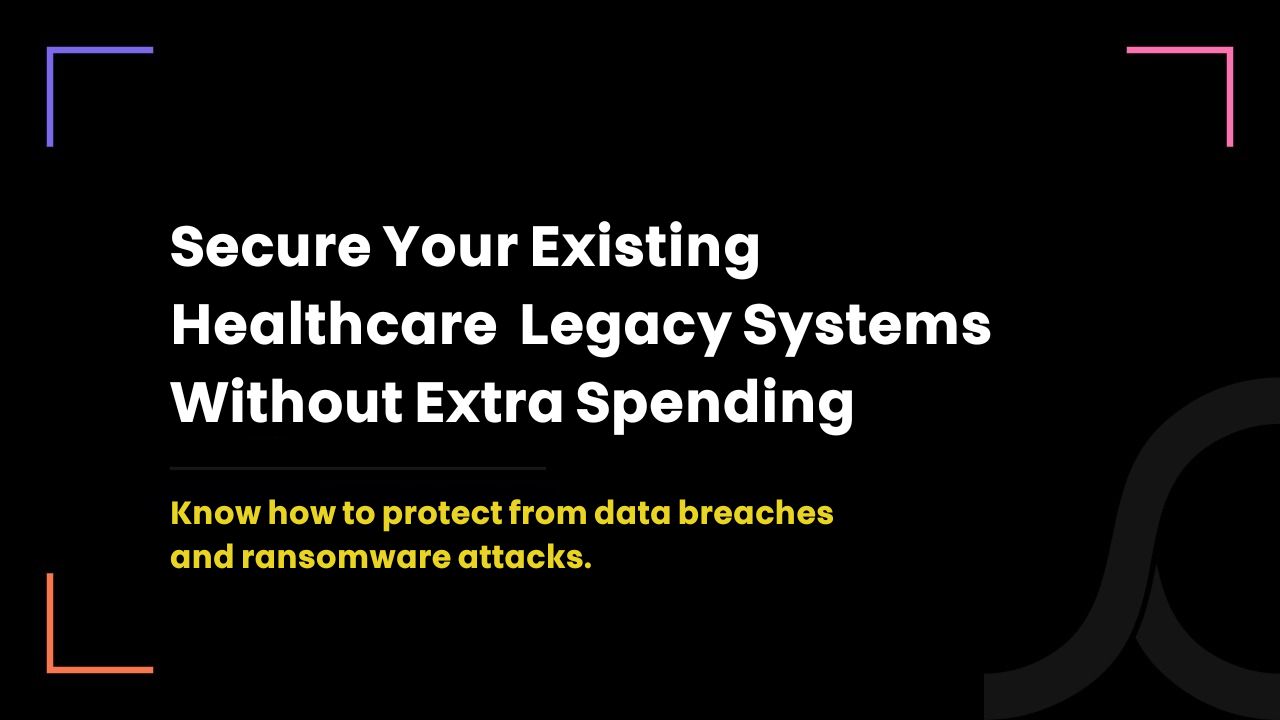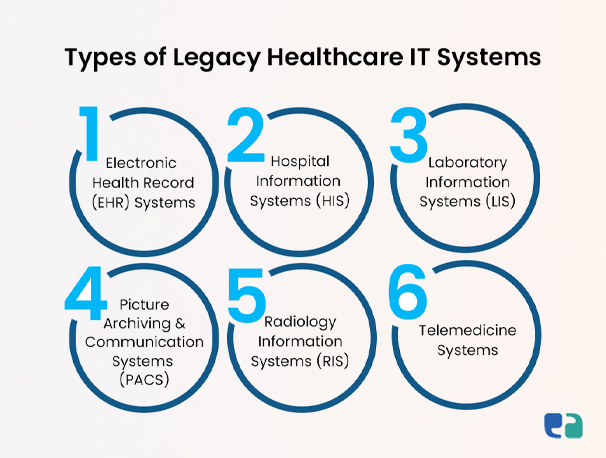Safeguarding Patient Data: Addressing Vulnerabilities in Legacy Systems

5 months ago
We all know how sensitive healthcare data is.
It contains patient records, personal information, and even financial details.
But for cybercriminals, it's an easy target to commit fraud.
As a result, healthcare is a prime industry for cyberattacks.
But you know who the villain is?
Healthcare legacy system—an outdated technology, still part of many healthcare organizations (>more than 73%).
According to the Cybersecurity and Infrastructure Security Agency (CISA), using these old systems is considered a "bad practice."
You will be surprised to know how much this costs; around $10.1 million per incident.
Isn't it unfortunate?
In Canada alone, the healthcare sector has faced repeated cyberattacks, with some incidents affecting millions of patient records and causing disruptions to hospital services.
- 14 major cyberattacks on Canadian health systems since 2015.
- A recent ransomware attack hit 5 Ontario hospitals.
- May breach compromised 3.4 million Ontarians' health data.
- Canada ranks 10th globally with 207.4 million compromised accounts.
Why Legacy Systems Put Healthcare at Risk
When technology becomes outdated, it starts to produce negative results. In the case of healthcare, it becomes even more dangerous.
These outdated technologies are made of old software, hardware, or data systems that are no longer supported by their manufacturers.
When a system is no longer updated, it becomes vulnerable to cyberattacks.
Here’s why this is such a big issue:
1. Security Risks
If there are no regular updates, then legacy systems are open to attacks.
Hackers can easily exploit the weaknesses in these old systems.
It is home to so many security gaps that an attacker can easily access.
2. Larger Target for Hackers
Cybercriminals know that legacy systems are easier to break into.
These outdated systems are not getting the security patches they need, which makes them attractive targets.
3. High Costs
Apart from a lack of efficiency, it welcomes security threats which costs millions to it.
The average price of a healthcare data breach is now $10.1 million, covering everything from loss of data to repairing the organization's reputation.
4. Compliance Issues
The problem with the outdated system is they don't follow the PIPEDA & HIPAA regulations adequately.
It can lead organizations to violate rules—leading to fines and legal issues.

Examples of Legacy Systems in Healthcare:
1. Old Microsoft Windows Versions
In Canada, many healthcare providers still use outdated versions of Windows, like Windows 7 or even XP.
Now the problem is, that they are no longer supported by Microsoft.
They miss the latest security features & essential updates that the new system has.
It leaves them exposed to new threats.
2. Proprietary Systems in Medical Devices
Some medical devices run on old systems that are no longer secure.
We know that these devices are very important for patient care but their outdated software puts them at risk.
By continuing to rely on these legacy systems, healthcare organizations are putting both their data and their reputation at serious risk.
The High Stakes of Legacy Systems: Risks to Patient Data and Operations
1. Data Breaches
The villain behind most data breaches in healthcare is legacy systems. They generally lack important security updates which make them vulnerable to cyberattacks.
- Over 40% of breaches are linked to third-party insiders with access to these systems.
2. Ransomware Attacks
Old systems are very lucrative to attackers as they are effortless to access and easy to exploit.
- Third-party vendors with access to legacy systems contribute to many attacks, emphasizing the need for strong security checks on vendors.

3. Operational Disruptions
It's not good for the efficiency of any healthcare organization.
- Communication delays and technical issues waste clinicians' time, leading to longer patient stays and higher costs.
- US hospitals lose about $8.3 billion annually due to outdated technology.
4. PIPEDA/HIPAA Violations
Many legacy systems fail to meet PIPEDA/HIPAA encryption standards, risking patient data security and leading to violations.

5. Cyber Risk & Technical Debt
Using outdated technology builds up technical debt, creating serious challenges:
- Increased cybersecurity risks, non-compliance, and integration issues with new systems.
- Limited growth and poor data interoperability between departments can harm patient care.
Why Modern Healthcare IT Systems are a Game-Changer for Healthcare Providers and Patients
1. Enhanced Security
When it comes to security, modern healthcare systems always prioritize it.
They offer up-to-date security features and regular patches to protect against cyber threats like data breaches and ransomware.
Features which safeguard sensitive patient data:
- Encryption
- Access control
- Multi-factor authentication
2. Improved Efficiency & Productivity
Gone are the days when staff used to do manual entry or repetitive tasks. Modern healthcare technologies streamline all the clinical workflow by automating tasks.
Thanks to AI which has taken automation to another level. Automation of administrative tasks reduces costs and frees up resources for better care.
The modern system gives more immediate access to patient records which helps providers to make faster decisions & better patient care.
3. Better Patient Care
With modern IT systems, healthcare providers get a comprehensive view of patient history.
The modern IT system empowers providers to make more accurate diagnoses and give personalized treatment.
It uses a data-driven approach that leads to a better quality of care & patient outcomes.
4. Compliance with Regulations
Modern systems are like your personal compliance superheroes, swooping in to save the day!
With built-in encryption, access controls, and audit trails, they make meeting HIPAA and PIPEDA a breeze.
No more worrying about fines – just smooth, secure, and trustworthy patient care!
5. Interoperability
One of the most concerning issues when it comes to legacy systems and modern tech infrastructure deals with it like a charm.
It makes sure data is shared across different platforms and healthcare providers/staff seamlessly.
When patient information flows smoothly, healthcare providers can make informed decisions.

Overcoming the Challenges of Upgrading Legacy Healthcare Systems
For the improvement of security, efficiency, and patient care, upgrading the legacy healthcare system is very important.
But it is full of challenges. Let's break them down and how you can overcome them.
1. Financial Constraints: Finding the Budget
Replacing old systems can be expensive, especially for larger organizations. See how you can manage costs:
- Look for funding opportunities like government grants or private investments.
- Go slow & upgrade in phases to spread out the costs.
- Conduct a cost-benefit analysis to show the long-term savings and justify the investment.
2. Integration Complexities: Making Systems Talk to Each Other
It's not easy to integrate old systems with new ones. Here’s how to make it smoother:
- Create a detailed data migration plan to move data from old systems to new ones. Make sure you ensure accuracy during this transition.
- Use APIs to help the systems communicate with each other.
- Consider middleware solutions to bridge the gap and simplify integration.
3. Downtime Concerns: Minimizing Disruptions
Healthcare can’t afford to have systems down for long periods. That's how you can minimize disruptions:
- Upgrade in phases, testing each step to avoid major downtime.
- Schedule updates during off-peak hours like nights or weekends.
- Have a disaster recovery plan in place in case something goes wrong during the upgrade.
4. Lack of Expertise: Getting the Right Skills
Legacy system upgrades often require specialized knowledge. To fill the expertise gap:
- Invest in training for your IT team to get them up to speed.
- Partner with experienced vendors who specialize in healthcare IT modernization.
- Bring in external consultants who can guide you through the technical complexities.
Get a personalized, no-obligation Free Technology Assessment to explore the right solutions for your needs and ensure a smooth upgrade process.
Securing Legacy Systems in Healthcare: How to Protect What You’ve Got
Upgrading a legacy system should be the goal, but if it's not possible due to budget constraints or you're not ready to make the leap just yet, make sure to utilize these tips in the meantime.
Here are a few ways to secure your legacy systems until you can modernize them:
1. Network Segmentation
One of the easiest ways to protect old systems is by isolating them.
You can limit threats by creating a separate network just for legacy systems.
This means if a hacker tries to breach, the damage is contained and won't affect the rest of your network.
2. Regular Vulnerability Assessments
Every system has weak spots, make sure you check yours regularly.
Legacy systems may have known vulnerabilities without patches, so you must find them early.
Once it's identified, you can implement protective measures, like using a firewall to block harmful traffic.
3. System Hardening
Make your legacy systems tougher by disabling unused services, closing unnecessary ports, and enforcing stronger password policies.
These simple steps reduce entry points and make it harder for attackers to break in.
4. Intrusion Detection & Prevention
You can set up Intrusion Detection and Prevention Systems (IDS/IPS).
If there are any unusual activities, this system automatically blocks the malicious traffic.
5. Endpoint Protection
Don’t forget the devices connected to your legacy systems.
Ensure they have strong endpoint protection to stop malware and other risks from spreading through the network.
Future Trends in Healthcare IT: Strengthening Security with Emerging Technologies
The way we used to handle security has changed with the evolution of healthcare.
Now emerging technologies like cloud computing, AI, and blockchain have strengthened it further, see how you can leverage them.
1. Cloud Computing
Do you know? Cloud providers invest more than on-premise systems when it comes to keeping data safe.
The best part is—cloud solutions make it easier to update and patch software. It eliminates the vulnerabilities which come with legacy systems.
With a cloud system, you can focus more on patient care instead of worrying about infrastructure.
2. Artificial Intelligence (AI)
AI helps detect and stop cyber threats in real time.
It analyzes data to find patterns that might indicate a security issue, like unauthorized access.
AI can also automate tasks such as scanning for vulnerabilities and fixing them, which makes security faster and more efficient.
3. Blockchain
New in healthcare, but it has a promising future that you can avail yourself of.
It keeps data safe because it’s difficult to change. With blockchain, you can easily share data across associated persons in the safest way possible.
It also helps build trust by keeping a permanent, clear record of all data exchanges.

Reference
- Forbes: Overcoming The Chronic Condition Of Cybersecurity In Healthcare
- rThreat | May 23, 2021: Securing Legacy Systems in the Healthcare Industry
- Bill Siwicki| March 02, 2023: How best to manage, or dump, legacy healthcare IT systems
- Brian Eastwood: Tips for Health Systems on Managing Legacy Systems to Strengthen Security
- The Cyber Express: Abandoning Legacy Systems; Route to Establish Cyber-Security in Healthcare
